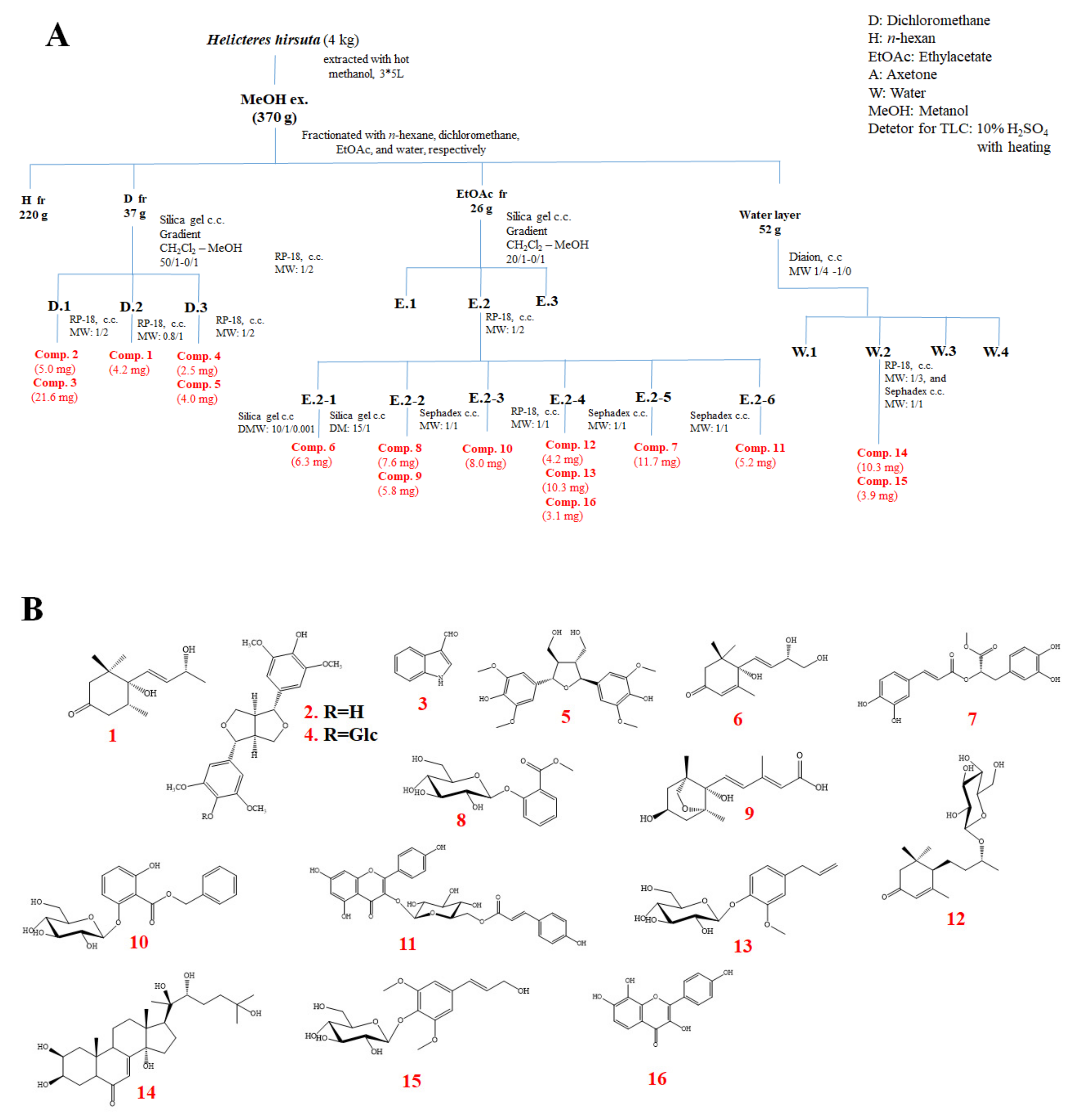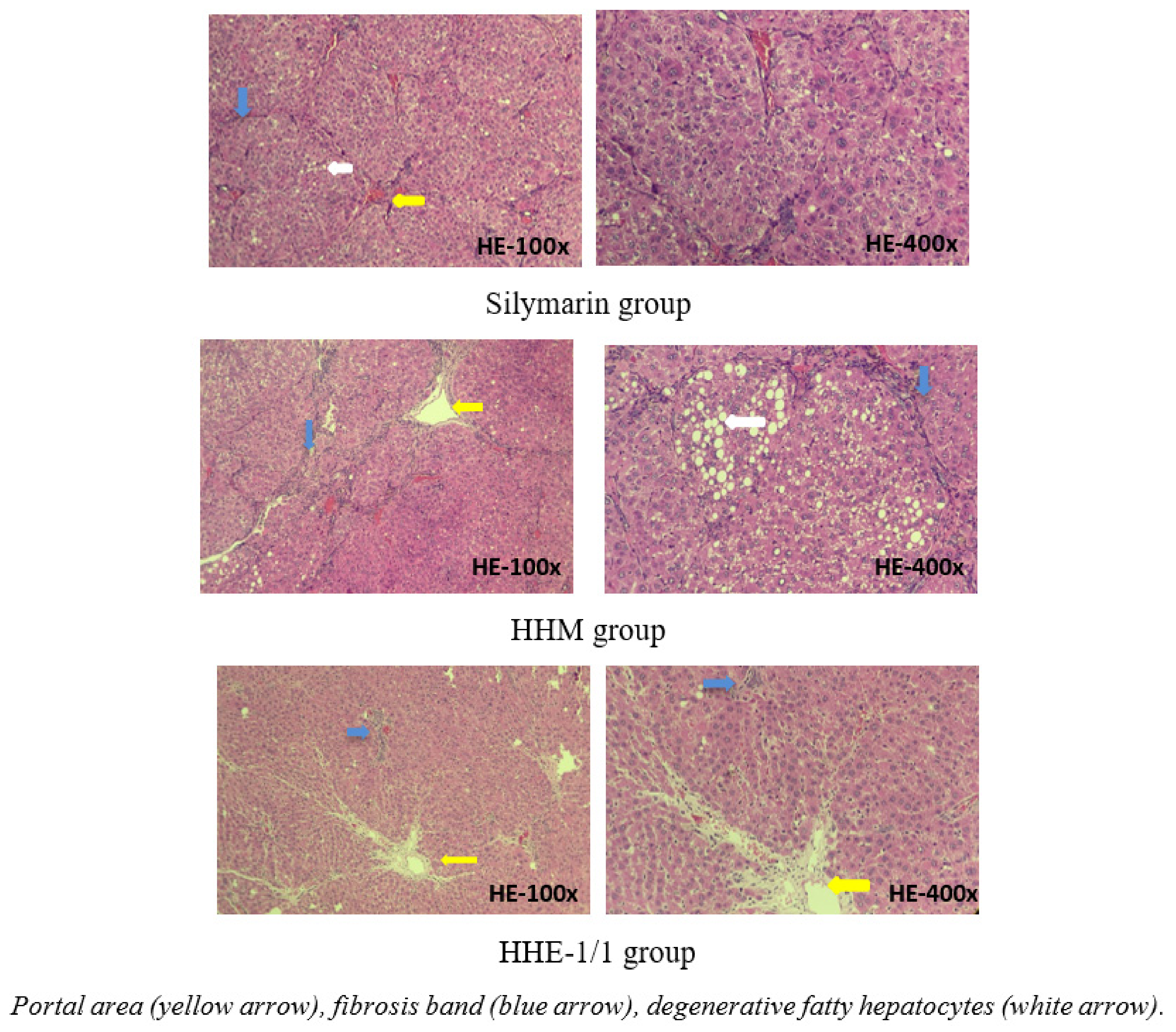Hepatoprotective Effects of Extract of Helicteres hirsuta Lour. on Liver Fibrosis Induced by Carbon Tetrachloride in Rats
Abstract
:1. Introduction
2. Results
2.1. Phytochemical Investigation of H. hirsuta
2.2. Effects of HHM, HHE-1/1 on Hematological Parameters
2.3. Effects of HHM, HHE-1/1 on Biochemical Parameters
2.4. Effects of HHM, HHE-1/1 on Histopathology of the Liver
3. Discussion
3.1. Effects of HHM, HHE-1/1 on Hematological Parameters
3.2. Effects of HHM, HHE-1/1 on Biochemical Parameters
3.3. Effects of HHM, HHE-1/1 on Histopathology of the Liver
4. Materials and Methods
4.1. Materials
4.2. Chemicals and Equipment
4.3. Extraction Methods
4.4. Statistical Analysis
5. Conclusions
Author Contributions
Funding
Institutional Review Board Statement
Informed Consent Statement
Data Availability Statement
Conflicts of Interest
References
- Gerush, O.V.; Iakovlieva, L.; Yu Koshova, O.; Spiridonov, S.O. Investigation of the mechanism of action of new hepatoprotective herbal drugs in the experiment. J. Glob. Pharma Technol. 2018, 10, 397–409. [Google Scholar]
- Zhou, W.-C.; Zhang, Q.-B.; Qiao, L. Pathogenesis of liver cirrhosis. World J. Gastroenterol. 2014, 20, 7312–7324. [Google Scholar] [CrossRef] [PubMed]
- Chi, V.V. Dictionary of Vietnamese medicinal plants. Biol. Pharm. Bull. 2012, 2, 1010–1013. [Google Scholar]
- Le Trung Hieu, L.L.S.; Nhung, N.M.; Vi, V.T.T.; Van Thi, T.T. Determination of methyl gallate and rutin from Helicteres hirsuta by HPLC and using methyl gallate content as a marker for the evaluation of antioxidant capacity. Vietnam J. Chem. 2018, 56, 342–346. [Google Scholar]
- Pham, H.N.T.; Vuong, Q.V.; Bowyer, M.C.; Scarlett, C.J. Phytochemical profiles and antioxidant capacity of the crude extracts, aqueous- and saponin-enriched butanol fractions of Helicteres hirsuta Lour. leaves and stems. Chem. Pap. 2017, 71, 2233–2242. [Google Scholar] [CrossRef]
- Pham, H.N.T.; Vuong, Q.V.; Bowyer, M.C.; Scarlett, C.J. Optimization of ultrasound-assisted extraction of Helicteres hirsuta Lour. for enhanced total phenolic compound and antioxidant yield. J. Appl. Res. Med. Aromat. Plants 2017, 7, 113–123. [Google Scholar] [CrossRef]
- Vinh, L.B.; Nguyet, N.T.M.; Yang, S.Y.; Kim, J.H.; Thanh, N.V.; Cuong, N.X.; Nam, N.H.; Minh, C.V.; Hwang, I.; Kim, Y.H. Cytotoxic triterpene saponins from the mangrove Aegiceras corniculatum. Nat. Prod. Res. 2019, 33, 628–634. [Google Scholar] [CrossRef] [PubMed]
- Nguyen, T.M.N.; Lomunova, M.; Vu, T.P.D.; Le, B.V.; Kim, Y.H.; Kang, J.S.; Hwang, I. Anti-allergic effects of the ethanol extract of Syzygium formosum (Wall.) Masam leaves and its immunoregulatory mechanisms. J. Ethnopharmacol. 2018, 211, 171–179. [Google Scholar] [CrossRef] [PubMed]
- Nguyen Viet, D.; Le Ba, V.; Nguyen Duy, T.; Pham Thi, V.A.; Tran Thi, H.; Le Canh, V.C.; Bach Long, G.; Kim, Y.H.; Tuan Anh, H.L. Bioactive compounds from the aerial parts of Hypericum sampsonii. Nat. Prod. Res. 2021, 35, 646–648. [Google Scholar] [CrossRef] [PubMed]
- Vinh, L.B.; Nguyet, N.T.M.; Ye, L.; Dan, G.; Phong, N.V.; Anh, H.L.T.; Kim, Y.H.; Kang, J.S.; Yang, S.Y.; Hwang, I. Enhancement of an in vivo anti-inflammatory activity of oleanolic acid through glycosylation occurring naturally in Stauntonia hexaphylla. Molecules 2020, 25, 3699. [Google Scholar] [CrossRef] [PubMed]
- Nallagangula, K.; Shashidhar, K.N.; Lakshmaiah, V.; Muninarayana, C. Liver fibrosis: A compilation on the biomarkers status and their significance during disease progression. Future Sci. OA 2017, 4, FSO250. [Google Scholar] [CrossRef] [PubMed] [Green Version]
- Qamar, A.A.; Grace, N.D. Abnormal hematological indices in cirrhosis. Can. J. Gastroenterol. 2009, 23, 441–445. [Google Scholar] [CrossRef] [PubMed]
- Bashour, F.N.; Teran, J.C.; Mullen, K.D. Prevalence of peripheral blood cytopenias (hypersplenism) in patients with nonalcoholic chronic liver disease. Am. J. Gastroenterol. 2000, 95, 2936–2939. [Google Scholar] [CrossRef] [PubMed]
- Wei, X.L.; Fang, R.T.; Yang, Y.H.; Bi, X.Y.; Ren, G.X.; Luo, A.L.; Zhao, M.; Zang, W.J. Protective effects of extracts from Pomegranate peels and seeds on liver fibrosis induced by carbon tetrachloride in rats. BMC Complement. Altern. Med. 2015, 15, 389. [Google Scholar] [CrossRef] [PubMed] [Green Version]
- Zhan, Y.Y.; Wang, J.H.; Tian, X.; Feng, S.X.; Xue, L.; Tian, L.P. Protective effects of seed melon extract on CCl(4)-induced hepatic fibrosis in mice. J. Ethnopharmacol. 2016, 193, 531–537. [Google Scholar] [CrossRef] [PubMed]
- Vargas-Mendoza, N.; Madrigal-Santillán, E.; Morales-González, A.; Esquivel-Soto, J.; Esquivel-Chirino, C.; García-Luna, Y.; González-Rubio, M.; Gayosso-de-Lucio, J.A.; Morales-González, J.A. Hepatoprotective effect of silymarin. World J. Hepatol. 2014, 6, 144–149. [Google Scholar] [CrossRef] [PubMed]






| Group (n = 10) | RBC (T L−1) | HGB (g L−1) | PLT (G L−1) | WBC (G L−1) |
|---|---|---|---|---|
| Control | 9.19 ± 1.38 | 157.21 ± 13.48 | 604.78 ± 82.11 | 14.67 ± 3.13 |
| CCl4 | 8.71 ± 1.15 | 122.00 ± 17.91 *** | 415.30 ± 137.57 ** | 26.69 ± 3.04 *** |
| Silymarin | 10.05 ± 0.91 ## 9.32 ± 0.84 | 146.00 ± 9.78 ## | 542.20 ± 167.71 | 23.82 ± 6.11 |
| HHM | 9.66 ± 1.25 ## | 153.50 ± 10.6 ### | 577.30 ± 79.84 ## | 20.52 ± 2.72 ### |
| HHE-1/1 | 156.40 ± 11.6 ### | 591.10 ± 106.77 ## | 22.19 ± 6 # |
| Group (n = 10) | AST (u L−1) | ALT (u L−1) | GGT (u L−1) |
|---|---|---|---|
| Control | 116.97 ± 19.00 | 53.55 ± 12.45 | 1.70 ± 2.11 |
| CCl4 | 2234.70 ± 325.19 *** | 903.37 ± 183.84 *** | 10.10 ± 3.38 *** |
| Silymarin | 1183.29 ± 276.57 ### | 730.55 ± 157.15 # | 6.00 ± 3.74 # |
| HHM | 1076.00 ± 398.50 ### | 452.35 ± 115.73 ### | 6.30 ± 4.40 # |
| HHE-1/1 | 1281.19 ± 325.15 ### | 691.26 ± 161.76 # | 5.54 ± 2.52 ## |
| Group (n = 10) | Total Protein (g L−1) | Total Bilirubin (µmol L−1) | Direct Bilirubin (µmol L−1) |
|---|---|---|---|
| Control | 79.86 ± 6.81 | 4.03 ± 1.00 | 0.59 ± 0.32 |
| CCl4 | 68.63 ± 6.46 ** | 16.64 ± 5.03 *** | 10.83 ± 4.97 *** |
| Silymarin | 79.69 ± 6.36 ## | 12.03 ± 4.71 # | 6.36 ± 3.18 # |
| HHM | 79.21 ± 1.89 ### | 12.57 ± 5.78 | 7.59 ± 4.18 |
| HHE-1/1 | 77.62 ± 3.78 ## | 13.55 ± 5.37 | 7.84 ± 4.34 |
Publisher’s Note: MDPI stays neutral with regard to jurisdictional claims in published maps and institutional affiliations. |
© 2021 by the authors. Licensee MDPI, Basel, Switzerland. This article is an open access article distributed under the terms and conditions of the Creative Commons Attribution (CC BY) license (https://creativecommons.org/licenses/by/4.0/).
Share and Cite
Thang Hoang, D.; Hien Truong, T.T.; Viet Duc, N.; Anh Hoang, L.T.; Do, T.T.; Vinh, L.B.; Young Yang, S.; Dan, G.; Tuan Anh, L. Hepatoprotective Effects of Extract of Helicteres hirsuta Lour. on Liver Fibrosis Induced by Carbon Tetrachloride in Rats. Appl. Sci. 2021, 11, 8758. https://doi.org/10.3390/app11188758
Thang Hoang D, Hien Truong TT, Viet Duc N, Anh Hoang LT, Do TT, Vinh LB, Young Yang S, Dan G, Tuan Anh L. Hepatoprotective Effects of Extract of Helicteres hirsuta Lour. on Liver Fibrosis Induced by Carbon Tetrachloride in Rats. Applied Sciences. 2021; 11(18):8758. https://doi.org/10.3390/app11188758
Chicago/Turabian StyleThang Hoang, Dac, Thi Thu Hien Truong, Ngo Viet Duc, Le Tuan Anh Hoang, Thi Thao Do, Le Ba Vinh, Seo Young Yang, Gao Dan, and Le Tuan Anh. 2021. "Hepatoprotective Effects of Extract of Helicteres hirsuta Lour. on Liver Fibrosis Induced by Carbon Tetrachloride in Rats" Applied Sciences 11, no. 18: 8758. https://doi.org/10.3390/app11188758
APA StyleThang Hoang, D., Hien Truong, T. T., Viet Duc, N., Anh Hoang, L. T., Do, T. T., Vinh, L. B., Young Yang, S., Dan, G., & Tuan Anh, L. (2021). Hepatoprotective Effects of Extract of Helicteres hirsuta Lour. on Liver Fibrosis Induced by Carbon Tetrachloride in Rats. Applied Sciences, 11(18), 8758. https://doi.org/10.3390/app11188758






